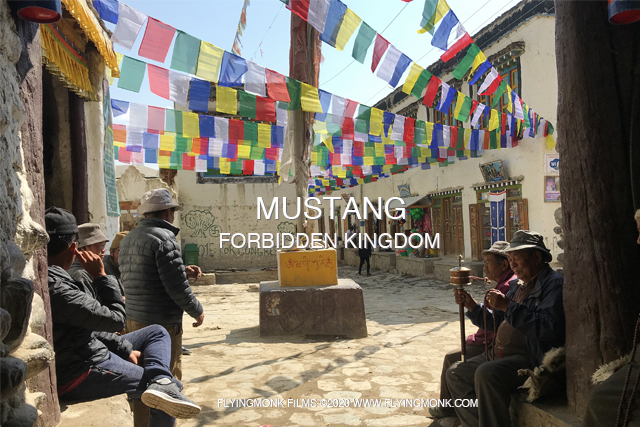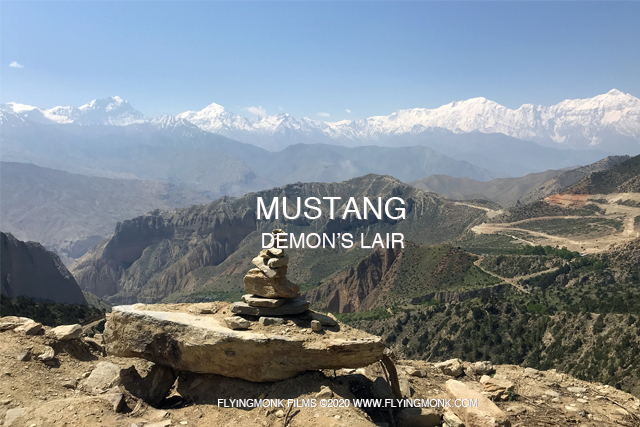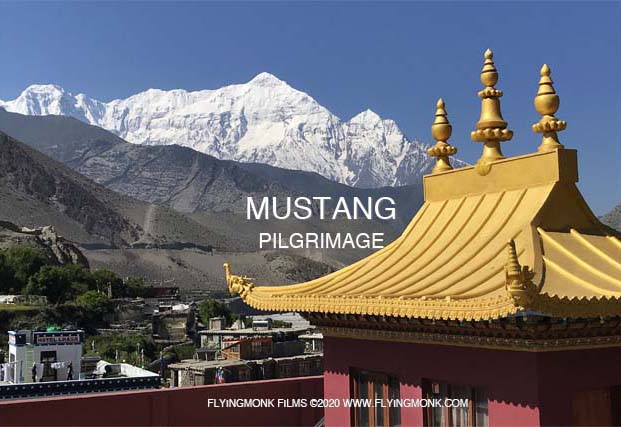Lo Manthang is not yet connected to the power grid. It runs on solar power that is used exclusively for room light and is not distributed to the outlets. As a result, the time when the generators start running, around 6 PM, both locals and foreigners jump to plug their phones and other devices in the few outlets that are available in the guesthouse kitchens because there are no outlets in the rooms. The kitchen power strips outlets become at that time the most coveted estate in Lo Manthang. The Chode Monastery’s guest rooms had the advantage of having generator power all night but for all the other places, the generator power is getting cut around 10 PM. However, in the entire town, you could see the power cable ran underground and mounts for electrical panels in front of groups of houses that is a sign that probably till the next festival the village would get connected to the grid.
During the festival, the village looks quite alive. Lots of foreigners from all over were in the village jamming the squares and roaming the alleys. Lots of them came here to trek for days in a row along the new or the old road, the same road on which I road in the jeep where the dust is on places 3″ thick and the relentless wind would constantly rise it to the skies like an offer to the gods of the future road to Tibet. When you trek on the road you step on these piles of dust and you feel like the monster from the legend because you move so much dirt under your feet and you leave deep tracks, covered quickly by the relentless wind. Nepal Tourism maps now new trekking routes to avoid the road that hopefully would be in place in two years from now. But in any case, trekking and visiting Upper Mustang is a much better experience than the one I had 17 years ago in Tibet where no food was practically available except instant noodles. Here wherever you go, you have good food in the restaurants, clean bottled water, OK beds in private rooms most of them with private bathroom, and even hot showers in every place. And as a bonus, starting this year, the cell towers can be used and you get sometimes a 3G signal that confers a clean Whatsup call and for me specifically, I can post this blog. Well, not all the time because most of the time you get the E on the phone and this only things you get through are limpid texts….It also exists a satellite-based Everest Wifi system across Nepal in which you can buy MB but the cost is prohibitive for blogging targeting mainly the high elevation expeditions.

Woman walking in Chhoser, Upper Mutsang, nepal
Most of the people left the previous day. Some will leave tonight and the village would reenter its lethargic life. Cows and horses would be driven home and women would still stand in the corner, knitting and gossiping protected by the penetrating lens of the cameras.
I decided to stay one more day in Lo Manthang and walk to Chhoser, a village at about 6 km off Lo Manthang. Chhoser is actually a collection of villages, maybe 7 of them that have caves and old monasteries hanging on rocks, all aligned on a valley of the river that tumbles dirty away. The walk to Chhoser is on a road, rarely passed by any vehicles larger than a motorbike but full of kids who are walking to the secondary school from one of the villages. We woke with them trying to engage them in a chat and gave them pencils and pens, in such a dire need everywhere in the country, like everything else, the looming and overpowering poverty of the Nepali villages.
After about 2 hours we reached the village that is the gateway to Chhoser caves and monasteries where we paid a foreigners’ entry fee of about $10 that include about four places to visit. I really hope that all these fees that are charged everywhere that may go to a good cause; taking pictures in the monastery come with a hefty fee, each day of the festival photo permit requires a fee, each monastery entrance has its own fee, always fees…

Shija Jhong caves, Upper Mustang, Nepal
The five stories Shija Jhong cave is just half an hour down the road, a luxury apartment that would have been called probably at the time, accommodating numerous families. You would hit your head navigating from one floor to another and explore lots of empty caves dug in the rock, each floor having at least 2-3 rooms with impressive views from various windows toward the valley and the river. The legend said that ruffians wanted to encircle and kill the dwellers and they blocked their water supply for several days. When they were sure that the dwellers would give up they saw a woman washing her hair in one of the windows. The woman was using oil but they thought that she was washing with water and gave up not knowing where the other source of water would be.

Lowo Nyiphug monastery, Upper Mustang, nepal
Lowo Nyiphug monastery hangs up on a cliff just across the river from the caves. You have to climbs steps to get to it and inside there are old tankas and murals that can be photographed. At its base, there is a monastic school that runs for about 25 years.
From the monastery, the road winds up on the cliffs around other caves used probably for meditation because they had some coloring inside and outside but currently occupied by herds of funny and fast tiny black lambs. It keeps going to the heart of the village where is the other Chhoser monastery.

Cave, Chhoser, Upper Mustang, Nepal
The old part of the village is made out exclusively of dug or natural caves, some having walls built out to protect from the rain and cold. All caves pockmark two adjacent hills, some being used as religious caves while others as living quarters Somebody built some staircases and renovated three of these caves, transforming them in a guesthouse in the sky and renting them for the time of Tiji festival with $50/cave!!! In a way, the caves reminded me of the ones in Matera, Italy only built in a less hospitable environment.

Chhoser old cave-houses, Upper Mustang, Nepal
The village has also a local daycare center with one teacher, possible funded by Jigme Foundation, the foundation started by the Lo Manthang’s Prince. I tried to find out from the local what is the prince’s name but nobody knew: ”We call him “the Prince”” We gave the kids more pencils and pens and all wanted to take pictures with us, so we obliged.

Suspended bridge in Upper Mustang
On the way back, we found Lo Manthang at a standstill. Every night of the Tiji festival, it was organized also a folklore festival for the villagers with village girls and boys performing traditional dances. This was the hype event of the day, way more popular for the locals than the Tiji, making men in the audience more excited by it than all the monks’ dances from during the day. But now all festivals were over, the foreigners were gone also and I found the square where all dances happened occupied by horses. A brand new mound of dirt was the sign that the work for bringing power to the local houses of the village continued and next year the village may be finally connected to the power grid.

Lo Manthang palace square, Upper Mustang, Nepal

























































































































You must be logged in to post a comment.